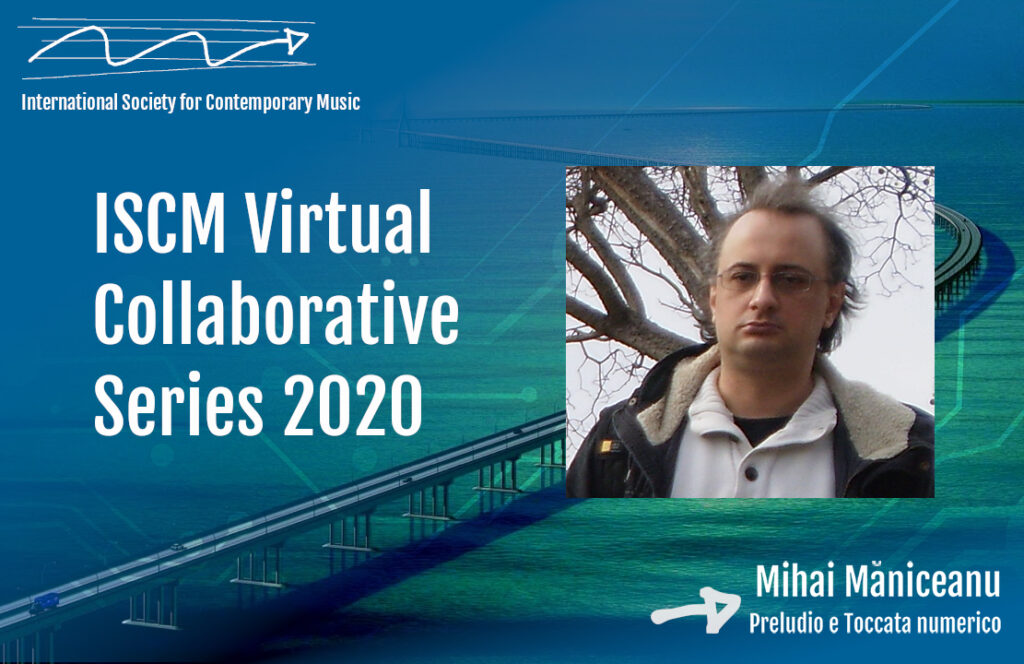Mihai Măniceanu: Preludio e Toccata numerico

(Submitted by ISCM – ROMANIAN SECTION)
Mihai Măniceanu (born in 1976 in Bucharest) studied piano (with Viniciu Moroianu) and composition (with Dan Dediu) at the National University of Music Bucharest. He completed his master course in piano and composition at the same university. In 2011 he graduated from the National University of Music Bucharest with a Ph.D. degree (with the highest academic honours, summa cum laude) in composition. He received an Erasmus scholarship at the University of Music and Theatre Felix Mendelssohn Bartholdy, Leipzig (2003-2004). UNMB scholarship at Muzikfest Festival, Hamburg (2001), Junger Künstler Festival–Filmmusik, Bayreuth (2002) and ISA 20. Internationale Sommerakademie, Murzzüschlag (2001). Nominated for Prometheus Opera Prima Prize (2009). Awards: First Prize at Icon Arts competition (Chanson pour un dromadaire fatigue) (2003), Romanian Academy Prize (Sus) (2011) and UCMR Prize for Symphonic Work ( Sempre risoluto) (2011).
As a performer Mihai Măniceanu is particularly involved in promoting contemporary composers. He is a constant presence in numerous concerts and festivals aimed at promoting contemporary music. Mihai Măniceanu is currently an Assistant professor for the Department of Composition, National University of Music.
Preludio e Toccata numerico is the first work of the cycle Mécanismes inoxydables. It begins with a short prelude in an improvisational manner, very characteristic of the baroque genre typology. It’s an introduction rather than a typical prelude. Once the moment is finalized, a frenzied toccata starts suddenly (attacca). The expressive character of the toccata is amplified by the use of chains that are in a constant vibration and by the chosen register for its evolution, the low one.
The toccata uses a modal key signature, which has an effect only upon the expressly specified pitches (local effect). For similar alterations in other octaves, accidents will appear along the way. This way of notation greatly simplifies the reading of the score, visually creating the impression of a predominantly diatonic music. The primary way in which the whole toccata is organized is around natural semitones, by adding upper and lower leading notes (D sharp, E, F, G flat, A sharp, B, C, D flat). The writing overlaps motives of different sizes between the two hands (from 2 pitches, up to 13 pitches). This overlap is, in fact, achieved through the rapid succession of the attacks of the two plans, the registers relating to them being largely the same. It is not a simple writing from the interpretative point of view, but perfectly realizable (each of the hands will be placed above the other or underneath, “trampling” somehow one over the other, depending on the context). Thus, the “theme” present in the right hand, due to the rhythmic considerations, will be counterpointed by a kind of offbeat countersubject, with a very similar constitution. The succession of the attacks between the two hands will be permanently varied intonationally due to motives of different sizes placed in overlay. In this way, results a music repetitive by itself, based on the principle of non-repetitiveness on the micro-structural level.
There are four blocks organized in this way, each on a different algorithm: algebraic progression (3/2, 4/3, 5/4, 6/5, 7/6, 8/7), the sequence of prime numbers (3/2, 5/3, 7/5, 11/7), the sequence of odd numbers (5/3, 7/5, 9/7), Fibonacci series (3/2, 5/3, 8/5, 13/8) – the numbers signify the pitches contained by every motive. The four blocks are delimited by some contrasting moments, of accord nature, inducing the suggestion of some grave percussion (timpani, bass drums). The last chord, a major chord only hypostasized by a fundamental and a third, presents an alternative of expressive order for the entire toccata.
Performed by Mihai Măniceanu

ISCM
